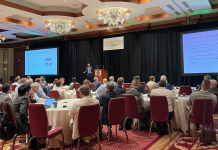Die-Bond’s Specialized Approach for Manufacturing Conformal Cooling Passages Makes Injection Molding Dies Run Faster While Minimizing Costs
Using a Liquid Interface Diffusion (LID) bonding process, Die-Bond joins split-layer injection molding dies containing complex conformal cooling passages. Our process significantly speeds up production time and minimizes overall die fabrication costs.
DIE-BOND offers the following capabilities:
- High vacuum hot pressing up to 100 tons maximum load

(platen size up to 24W x 24D) - Vacuum controlled atmosphere heat treating
- Prototype engineering projects
- Diffusion bonding (up to 2200° F)
- Conventional vacuum brazing and heat treating
- Conventional tool materials include: H-13, 420, S-7, Stavax Supreme, 316L, 433 and many other possible materials
Using a Liquid Interface Diffusion (LID) bonding process, Die-Bond joins split-layer injection molding dies containing complex conformal cooling passages. Our process significantly speeds up production time and minimizes overall die fabrication costs.
Engineered with precision, Die-Bond’s LID bonding method:
- Hermetically joins split-layered die designs allowing complex conformal cooling passages to be easily built in
- Minimizes braze alloy fillet plugging problems
- Yields bond lines with much higher bond strength and ductility to ensure consistent hardening following post-bond machining operations
- Maintains the flat surfaces necessary to minimize die-material waste
- Dramatically improves bonding yield compared to conventional vacuum brazing operations
HOW DOES DIFFUSION BONDING WORK?
 Die-Bond stacks parts inside a specialty vacuum hot press (VHP) that applies the large tonnages needed to bring the parent metal atoms together during the joining operation. Then, with a unique combination of time, temperature, pressure, and high vacuum with a controlled reducing atmosphere, the plates combine to form hermetic joints along the bond line, and come out with a “bright anneal” surface condition.
Die-Bond stacks parts inside a specialty vacuum hot press (VHP) that applies the large tonnages needed to bring the parent metal atoms together during the joining operation. Then, with a unique combination of time, temperature, pressure, and high vacuum with a controlled reducing atmosphere, the plates combine to form hermetic joints along the bond line, and come out with a “bright anneal” surface condition.
As needed, our process can use thin eutectic platings (NiP or NiB), or single layers of very thin  braze alloy foils (0.0015″ nominal), to minimize the surface finish requirements of the parts being bonded and to reduce the time (and cost) required to make very hermetic structures. Also, by request, parts may be diffusion bonded and annealed to a very soft condition during the post bond cool-down. This technique allows for a majority of the die machining to occur after the bonding operation, with the material in the soft “full annealed” condition.
braze alloy foils (0.0015″ nominal), to minimize the surface finish requirements of the parts being bonded and to reduce the time (and cost) required to make very hermetic structures. Also, by request, parts may be diffusion bonded and annealed to a very soft condition during the post bond cool-down. This technique allows for a majority of the die machining to occur after the bonding operation, with the material in the soft “full annealed” condition.
Die-Bond’s diffusion bonding process also allows small mold inserts to be hardened under extensive tonnage, reducing the risk of warping during the “quench” cooling used during normal vacuum brazing operations. The results are yields that are more consistent and reduced costs for injection molding die manufacturers.























